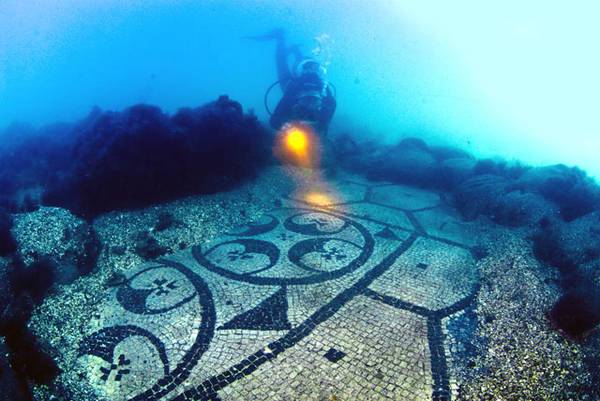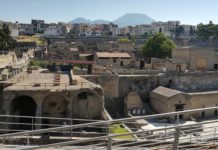What’s under the sea? Monica tells us, that the project for Monitoring innovative coastal and marine environment coordinated by INGV-Vesuvius Observatory, in collaboration with the National Research Council, and aims to draw the underwater scenery of the waters of the Bay of Pozzuoli, north of Naples. Where were identified new fumaroles marine and studied in detail archaeological remains submerged due precisely to a detailed bathymetric map of the seabed, recently published in the Journal of Maps. Roman walls, pavements and ancient relics of two thousand years ago between emanations of volcanic gases. The high-resolution bathymetric map developed by the Observatory of Vesuvius (Ov) of the National Institute of Geophysics and Volcanology (INGV), in collaboration with the Institute for Coastal Marine Environment (IAMC) of the National Research Council of Naples.
The study High-resolution morpho-bathymetry of Pozzuoli Bay, southern Italy, funded by the Ministry of Education, explored the port facilities, residential complexes and thermal age ‘Roman, as the Portus Iulius and the villa of Pisoni, submerged by the sea due vertical movements of the ground, in a rich context of fumarolic emissions to the volcanic nature of the territory. The team of researchers has reconstructed partenopei the morphology of the marine identifying, using multibeam echo sounder, the presence and location of archaeological structures up to about 15 meters depth. “But there’s more – says Renato Somma, researcher of the OV-INGV – have been discovered previously unknown areas of emission of volcanic gases, and identified marine terraces at various depths. The bathymetric survey gave a picture of the unprecedented morphology of the seabed of the Bay of Pozzuoli and is a contribution to the understanding of the evolution of Campi Flegrei caldera, a volcanic area active at high risk, inhabited by nearly a million people. ” The map, produced at a scale of 1: 10000, is also an important tool for the definition of multi-risk scenarios and for monitoring the evolution of the coastal areas. “The Bay of Pozzuoli – says Giuseppe De Natale, director of the OV-INGV and project coordinator Monica – forms the central part of the Campi Flegrei caldera, vulcanotettonica large structure that was formed following the volcanic eruptions of ignimbrite Campana (the largest explosive eruption occurred in the bell 39,000 years ago) and the Neapolitan Yellow Tuff (the second in importance in the bell eruption, 15,000 years ago). [charme-gallery]
“The last eruption occurred in 1538. In the past, the area has been repeatedly affected by ground movements associated with the dynamic volcanic and recently there have been two further episodes of bradyseism, in the years 1969-1972 and 1982-1984, which produced a total lifting of the ground about three feet, accompanied by swarms of earthquakes of low energy. In the past decade about the movement of the soil is taken up and has produced a rise of about 28 cm in today, “explains De Christmas. Monica The project is aimed at the prevention and management of environmental emergencies, especially marine and coastal areas, including through the creation of a monitoring system for optical fiber, consisting of sensors installed on the seabed, which will complement the existing systems on the ground . “The goal is to establish a system for monitoring coastal marine who, together with ground-based systems, is able to control natural phenomena such as earthquakes, eruptions, landslides, tsunamis and may further be implemented with sensors capable of detecting biological parameters and marine pollution, as well as man-made phenomena such as maritime traffic etc.”, continues De Natale. The Digital Terrain Model emerged area of Pozzuoli (DTM), produced in the course of this study, has been integrated with that achieved in previous campaigns, research and data on the coastal area of the Campi Flegrei, acquired in 2004 by the Region of Campania . “Additional findings being made will install an underground fiber-optic submarine cable that will connect ‘to the mainland some geophysical monitoring stations located on the seabed”, said the director of the OV-INGV.

 Italiano
Italiano














